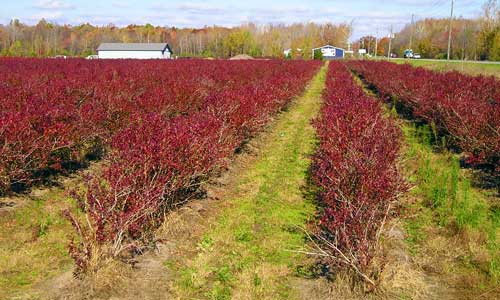Fall color show and winter dormancy in woody plants
Brightly colored leaves mark a plant’s transition to winter dormancy as nutrients are stored for next spring’s growth.
The brilliant fall foliage we see is the results from the breakdown of the chemical machinery in the leaves as the plant stores those materials for growth next spring. Leaves are just temporary organs; the plant uses them to make sugar from sunlight by photosynthesis. Now that winter is coming, the deciduous perennials breakdown the proteins and other chemicals in the leaves and store them in the buds, bark and wood for growth next spring. The colors are accessory pigments that helped protect the chlorophyll in the leaves from breakdown by the sunlight during the season.

Bluecrop blueberries are a deep red by the end of October. Photo credit: Mark Longstroth, MSUE
The plant’s first clue that winter was coming is when the days began to get shorter. Plants track the hours of daylight during the day. In late summer (August), the day length really begins to change and the days rapidly begin to shorten. By the first day of fall when the day and night are of equal length, perennial plants are getting ready for winter. Cooler temperatures are also an indicator that winter is on the way. The fats and proteins in the cells of the wood and bark that will overwinter are changed from forms that work best in the warm summer to forms that function when the temperatures are near freezing and can survive freezing and thawing in the winter.
Freezing temperatures are the plants final clue that winter is coming. Many woody perennials lose their leaves as they become dormant, such as maples and apples. Evergreen plants such as pine trees, strawberries and cranberries keep their leaves all winter. For evergreen plants, water loss during the winter can be a big problem if the ground is frozen.
As the temperatures get colder, plants acclimate to the cold, entering a state of deep dormancy when they will not grow, even if the conditions are good for growth. You can take cuttings from a plant in the late fall or early winter and these cuttings will not grow. Horticulturists used to call this rest, but now use the term endo-dormancy (endo is Greek for inside), meaning that something inside the plant is causing it to remain dormant. The plants that live through Michigan winters track the cold of winter to keep them from growing during warm spells in early winter. Many plants have a winter chilling requirement and will not grow until chilling is completed.



 Print
Print Email
Email


